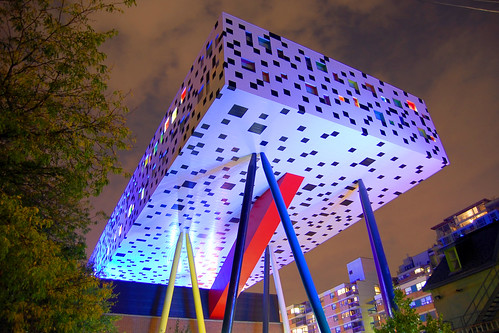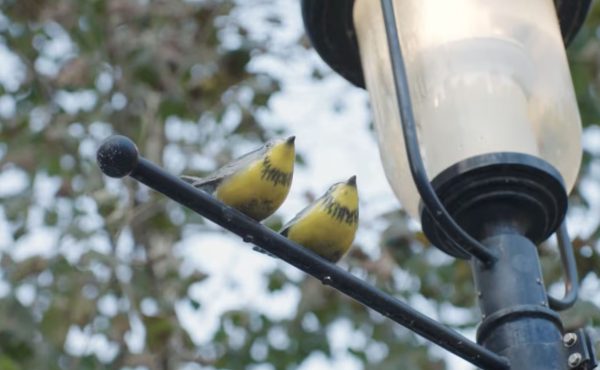

Cities are for a lot of things, but they’re mostly for people. Or should be. We can all point to many examples where the people get overlooked and urban design is driven by something else. Maybe it’s the car that takes precedence, or a building that meets the sidewalk poorly, or maybe people just get overlooked because the designers forgot who they’re ultimately designing for.
Over the last month and a half, I’ve been teaching a brand new third year workshop course at OCAD called Cities for People. With Toronto as our laboratory, we looked at interesting initiatives and designs around the city, and talked about how we could make the not-so-good parts better. We walked around St. Jamestown while hearing about the Mayor’s Tower Renewal program from Graeme Stewart of ERA Architects who originally created the project; wandered south into Cedarvale Ravine from Eglinton West with Todd Irvine from LEAF and Laura Reinsborough from Not Far From the Tree thinking about the urban forest and how to harvest residential fruit trees; wandered the streets of the former Borough of York looking at community art projects with Katherine Earl from Art Starts; and even made our way to Long Branch to see the suburban gardens of South Etobicoke. From the Toronto Archives, Wychwood Park and Green Barns, HtO Park on the waterfront, and the PATH system, Toronto was our classroom.
In part, their main assignment was to pick a neighbourhood that isn’t one of Toronto’s “superstar hoods” (that is, not the Annex, Queen West, Kensington or any of the places we hear enough about already), undertake some primary and secondary research and (quickly!) identify an issue or narrative thread in the neighbourhood that would then be the crux of a design intervention they create to either address that problem or encourage what’s already happening there. Over the coming days we will be featuring some of their work here on Spacing to both show you what some of these talented OCAD students are up to and also to invite our readers to share their thoughts on the work — so stay tuned for more Cities for People.
Photo by John Vetterli.




10 comments
“Maybe it’s the car that takes precedence, or a building that meets the sidewalk poorly, or maybe people just get overlooked because the designers forgot who they’re ultimately designing for.”
…or the public system is so underdeveloped that doesn’t have almost any influence on the shape of the city, or the private sector doesn’t have any knowledge or interest in urbanity, or the public doesn’t have almost any access to the city making process, or…
Sounds like a great course. Looking forward to the postings!
…pick a neighbourhood that isn’t one of Toronto’s “superstar hoods†(that is, not the Annex, Queen West, Kensington or any of the places we hear enough about already)….
Hey those neighbourhoods are all in my ward… what gives!?!
Sounds like a great class… please fell free to share the ideas with us at city hall
Well, since OCAD is in WARD 20, we talked a lot about it naturally, either looking out the window or when our tours started at the school, rather than in a remote location (remote from OCAD).
Getting art students to solve our urban problems??
Why not ask the people at George Brown learning to be chefs to give their ideas?
Anonymous Angus> What gives? You’re a troll and this doesn’t deserve a response, but
1> They are designers, this is what they do, and will do, and this is how the process works students trying things out in school and then move into real world jobs
2> They had a real interest in putting their ideas out in the public to see what people think, but I warned them, there are people who will poop in the comment section, as you do, with nothing substantive to add but that poop. Thank you for providing the example.
3> Some of the best ideas that have become real things started as school projects — historical context would constipate your pooping though.
And since you ask, Angus, it’s entirely possible the chef trainees might have some good ideas for solving some of Toronto’s problems. Ideas like these, for instance: http://www.yesmagazine.org/article.asp?ID=3330
Brilliant concept for a course. Hope you can get Toronto troglodytes to hear you (Torontlodytes?). Bon chance!
Send some people to Cabbagetown’s Parliament street: Gerrard to Wellesley. There’s a confused area. I live on a teacher’s income, but nobody else here seems to be middle income. I’d be happy to show them around, while I am off work and in town this July. Love to give you my contact info., but not on a public forum.
You ought to put a feedback link and comments form in with your articles from this course so readers — some of them white-haired old geography majors from ancient days — could pass their thoughts on to you.
That map in the East Chinatown article has an awful lot of easily correctable technical (as opposed to conceptual) problems, for example, no doubt due to inexperience. Ever heard of a “North Arrow” or the convention of putting north at the top….Grrr! Or making it possible to print the map on a single sheet of paper? Or having the legend with the text reading the same side up — that is, not “right side up” on one side of the street and “upside down” on the other…this is not as bad on a paper map that you can rotate, but dreadful on a computer screen for web use, and the map is not printable!
Then you may possibly have missed some important historical geographical points about the neighbourhood. First, as to why people still come to shop there: the larger Chinese grocery stores are cheap – you can save significant amounts on a weekly shop there over mainstream supermarkets like Loblaw’s and Metro, or uptown Chinese stores, but the quality is not perhaps, as good and the staff are certainly not as friendly for the most part.
Then, second: those two or three huge apartment towers to the west just five minutes walk across the Don River Bridge on Gerrard are a longstanding Toronto immigrant reception area with successive waves of new refugee ethnicities as occupants different groups, fleeing various conflicts, come into Toronto. East Chinatown, I believe, got its start as an ethnic commercial strip as a group of Vietnamese refugees flooded into the buildings about thirty years back (maybe even longer ago, and is this really the right story?), and commerce or local entrepreneurship (I am not sure which it was but would be interested to know since I lived a couple of blocks away for years?) followed. This group got economically integrated fairly fast and long ago moved north following the classic immigrant migration pattern, with some of the stores following, and others closing. One wonders who lives in the apartment towers now, or if the Sri Lankan Tamil stores on Parliament Street to the northwest still have their own demographic base of customers in the St. Jamestown apartment complex, a not dissimilar situation?
Curiously (sorry for the digression but perhaps ethnic shopping strips generally often go through several distinct phases, and it is worth examining the patterns) the “Little India” strip on Gerrard west of Coxwell about a kilometer away seems to have had a different sort of development history. There was no nearby South Asian resident population. Rather, the area was about an equal driving distance from a number of concentrations of immigrants from the Subcontinent, segregated somewhat by language group — Punjabi speakers in one neighbourhood, Gujarati speakers in another, and Tamil speakers yet elsewhere, etc. etc. Someone opened an Indian cinema in the area and a number of other stores, attracted to the crowds it drew, opened nearby, ultimately resulting in a large and thriving “Little India” shopping zone that had a considerable drawing power and whose catchment area even extended into the northern tier of the USA. Subsequently, the more distant areas began to support their own “Indian” stores, sometimes branches of the Gerrard and Coxwell ones, and the original Little India “monopoly” began to face commercial pressure.
Don’t know how it is doing recently. Like everyone else I moved north and don’t get much chance go back any more and just hang around.
I doubt it’s econimically viable, but I think what every fading immigrant ethnic strip really neads in its twilight years is a nice bakery that stays open late at night and has an espresso machine and a sidewalk patio –repeat: PATIO!– right in the heart of what still is lively, so all the older people who used to live around the area coming back to hang around for an afternoon for a nostalgia’s sake have a place to sip a cappucino and watch the street life go by. I loved this on Bell Boulevard in Bayside, Queens, in New York City. Perfect!
Mat-Who-Used-to-Live-Near-East-Chinatown-and-Who-Would-Love-to-Know-More-About-Its-History-While-There-Are-Still-People-Who-Remember
Thanks for your comments Mathew. There is a comment form underneath each post in this series though, as there are all posts on Spacing. We did mention at the end of the Chinatown post that there was some problems putting some of the material on the web. They were never designed specifically for going online or even for printing — but we wanted to share some of the ideas and work here nonetheless.